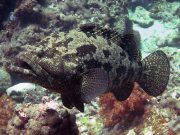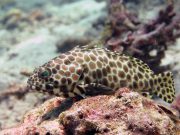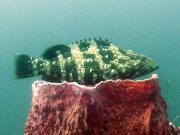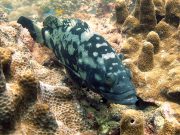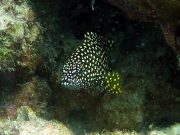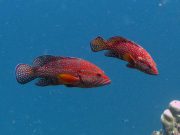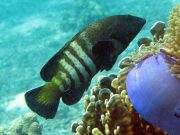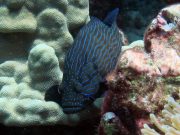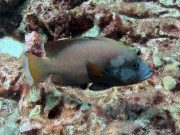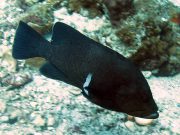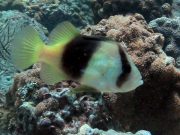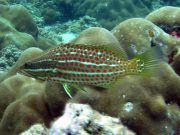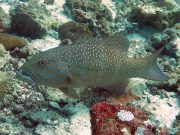Brown Marbled Grouper
(Epinephelus fuscoguttatus)
Epinephelus fuscoguttatus @ Koh Haa
The brown-marbled grouper has a sharp head profile, big mouth, and a pale yellowish brown body and fins, with many close-set small brown spots. The body has a series of five vertical irregular brown blotchy sections and can be identified by the small dark or black saddle on the tail base. All the fins are large and round.
The brown-marbled grouper is one of the largest fish that we regularly see on almost all of the dive sites around Koh Lanta, particularly around Koh Haa, Hin Muang & Hin Daeng. This stocky and robust species grows to 120 cm, but is usually observed in the 50 cm - 60 cm range. Larger individuals of 60 cm +are sometimes encountered. This is usually a solitary groupe, but occasionally observed in small groups.
This species is an ambush predator and its diet includes fish, crustaceans and cephalopods. It has a well defined territory which it will defend against intrusion from other brown-marbled groupers.
Longfin Grouper
(Epinephelus quoyanus)
Epinephelus quoyanus @ Koh Bida
The longfin grouper has an underlying white body colour, covered with close-set polygonal spots (usually five or six sides) in varying shades of brown. There is a broad dark margin on the anal fin, and a brown diagonal band across the breast.
This species can be distinguished for several other similar looking groupers (e.g. honeycomb grouper - Epinephelus merra) by two darkish bands below the pectoral fin base. The tips of the dorsal fin spines are white.
The longfin grouper has large pectoral fins which are used to sit on corals and the sandy or rubble bottom close to the reef.
This solitary species grows to 38 cm, but is often observed smaller, in the 15 cm - 20 cm range. The diet includes shrimp, small fish, worms and crabs.
Malabar Grouper
(Epinephelus Malabancus)
Epinephelus Malabancus @ Koh Haa
The Malabar Grouper is a large fish with a generally light brown or olive grey colour and around 5 mottled bars on the body. There are numerous small while spots and blotches on the body and many smaller dark spots.
Larger individuals often have a lighter coloured body with larger pale areas. The tail fin is rounded.
The Malabar Grouper is usually seen in deeper parts of the dive sites, often 20m + and can be observed alone, or in small to medium groups, sometimes resting on the reef or hovering close to it.
The Malabar Grouper grows to 230 cm and is one of the largest fish we regularly see while diving around Koh Lanta.
The diet includes mostly other fishes and crustaceans, and occasionally cephalopods.
Cloudy Grouper
(Epinephelus erythrurus)
Epinephelus erythrurus @ Koh Bida
The Cloudy Grouper has a dark grey body with irregular pale spots and blotches randomly joined to form a maze-like pattern.
The Cloudy Grouper grows to 45 cm and is solitary, usually seen at all of our dive sites resting on coral, or the sandy bottom close to the coral reef.
Speckled-fin Grouper
(Epinephelus ongus)
Juvenile Epinephelus ongus @ Koh Haa
The Speckled-fin Grouper has a dark brown body with large white blotches on the head, body and fins that become elongate 'streaks' in larger fish.
The spots on the head are smaller than those on the body. There is a dark submarginal band on the dorsal, anal and tail fins.
Juveniles have a black body with many white spots on the body, dorsal and tail fin. There are smaller white spots on the head, and the pectoral fins are yellowish, with bright yellow spots.
The Speckled-fin Grouper grows to 40 cm and feeds on crustaceans and fishes.
This species is not often seen at the dive sites around Koh Lanta.
Coral Grouper
(Cephalopholis miniata)
Cephalopholis miniata @ Koh Haa
The coral grouper has an orange-red to reddish-brown body, usually darker toward the rear. The body and fins (except pectoral fins) are covered with hundreds of dark-ringed, bright blue spots. The pelvic fins are a bright orange-red colour, and there is a narrow blue margin on all fins except pectoral fins. This species may occasionally display pale blue bars.
This is a territorial species where a single male dominates a harem of up to 12 females over a large home territory. Each female guards her individual area of up to 40 square meters against intrusion, and is visited by the dominant male once or more per day.
The coral grouper feeds on small fishes and crustaceans. This species grows to 41 cm, but often observed in the 20 - 30 cm range.
Peacock Grouper
(Cephalopholis argus)
Cephalopholis argus @ Koh Rok
The peacock grouper is typically found sitting on corals and has a brown body, with adults showing five or six pale bars on the rear part of the body.
The body is covered with hundreds of small blue spots with black edges. The rear dorsal, anal, tail and pectoral fins have large blue borders. There is a lighter coloured patch at the pectoral fin base.
The peacock grouper can grow to 55 cm bus is usually observed 25 - 35 cm, perhaps slightly longer.
This species has both a dark and pale phase and can rapidly change between them both. Often found solitary or in small groups, which may include a single dominant male.
Bluelined Grouper
(Cephalopholis formosa)
Cephalopholis formosa @ Koh Haa
The bluelined grouper has a dark brown body, sometimes yellowish brown, with irregular horizontal blue lines on the head, body and fins. The fins are generally darker than the body.
This species likes to rest on corals, often on, or close to dead corals, and uses its large pectoral fins to support its body. The pectoral fins are larger than the pelvic fins.
The bluelined grouper grows up to 34 cm, but is usually observed in the 15 cm - 25 cm range. This is a solitary species, which feeds on small fishes and crustaceans.
Redmouth Grouper
(Cephalopholis rogaa)
The redmouth grouper is often seen with the dark, brown or black body, but may occasionally be seen with a light orangish-brown body.
This species frequently has a pale bar across the abdomen, and may have light or whitish margins at the rear of the dorsal, anal and tail fins.
Cephalopholis rogaa @ Koh Bida
The redmouth grouper has a continuous dorsal fin that is elongated to the rear, with a matching elongated anal fin, both trailing back toward the short tail fin.
The head and snout form a steep angle, and the jaw extends beyond the eye. The inside of the mouth ranges from light pink to crimson.
Cephalopholis rogaa @ Koh Haa
The redmouth grouper is a solitary species that grows to 60 cm, but usually observed 25 cm - 35 cm. This species defends its home territory hunting ground against competitors, and employs a slow moving hunting technique.
The grouper swims through shoals of small fish, occasionally swallowing one or more fish from the shoal.
The diet also includes stomatopods and crustaceans which it finds while hiding under ledges or in reef crevices.
Chocolate Grouper
(Cephalopholis boenak)
Cephalopholis boenak @ Koh Haa
The Chocolate Grouper has a brownish to greenish-grey body, usually with 7 to 8 dark bars on the side.
The tail fin is rounded. The real dorsal, anal and tail fins have whitish margins and dark sub-margins.
The Chocolate Grouper grows to 30 cm but more often seen around the Lanta dive sites at 10 cm - 15 cm in length.
This species feeds mainly on fish and crustaceans.
Two-banded Soapfish
(Diploprion bifasciatum)
Diploprion bifasciatum @ Koh Bida
The two-banded, or double-banded soapfish is a member of the grouper family, however it does not look, or behave like a grouper. This species has a pale to bright yellow head, body and fins. There is a dark or black eye bar, and a broad dark or black bar from the middle of the dorsal fin to the anal fin. Occasionally this species may have a nearly all-black body.
The two-banded soapfish grows to 25 cm, but usually observed in the 10 cm - 15 cm range. This species is seen solitary, or in small groups, and has a large, expandable jaws, which allow it to swallow surprisingly large prey.
When stressed, the soap fish may release toxins from their skin which can resemble lathered soap.
Slender Grouper
(Anyperodon leucogrammicus)
Anyperodon leucogrammicus @ Hin Bida
The Slender Grouper has a greenish to brownish grey body with many red-orange spots on the head and body, arranged in several horizontal rows. The spots become smaller toward the rear body.
There are 3 - 4 light horizontal bands or stripes which of varying intensity depending on mood. The tail fin is rounded.
The Slender Grouper grows to 52 cm, but more usually observed in the 20 cm - 25 cm range.
This species is solitary, with a diet which included other, smaller fishes.
Roving Coral Grouper
(Plectropomus pessuliferus)
Plectropomus pessuliferus @ Koh Haa
The Roving Coral Grouper has a brownish to reddish to olive elongate body with many small dark edged blue spots on the body and fins.
Spots on the head and body may be elongate, particularly on the mid to rear body, forming vertical dashes. There is a thin blue ring around the eye. There may be five to six dusky bars on the body.
This species can easily be misidentified as Plectropomus maculatus, however is distinguished by the vertically elongated blue spots on the body.
The Roving Coral Grouper grows to 125 cm and can be found in coral rubble areas, though is rarely seen at the dive sites around Koh Lanta.

